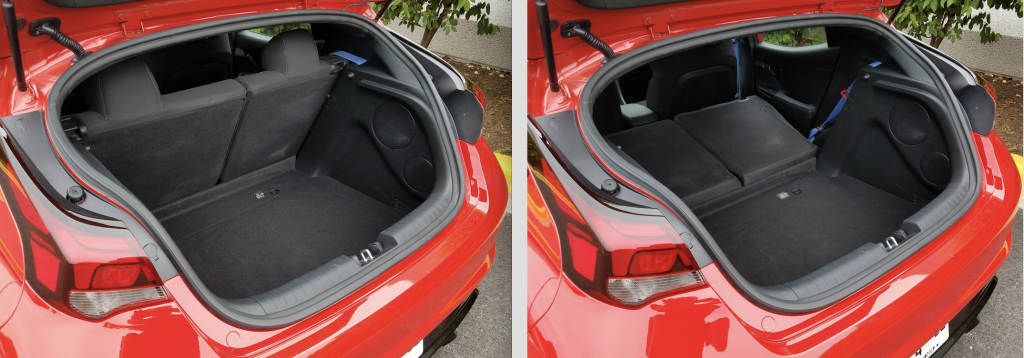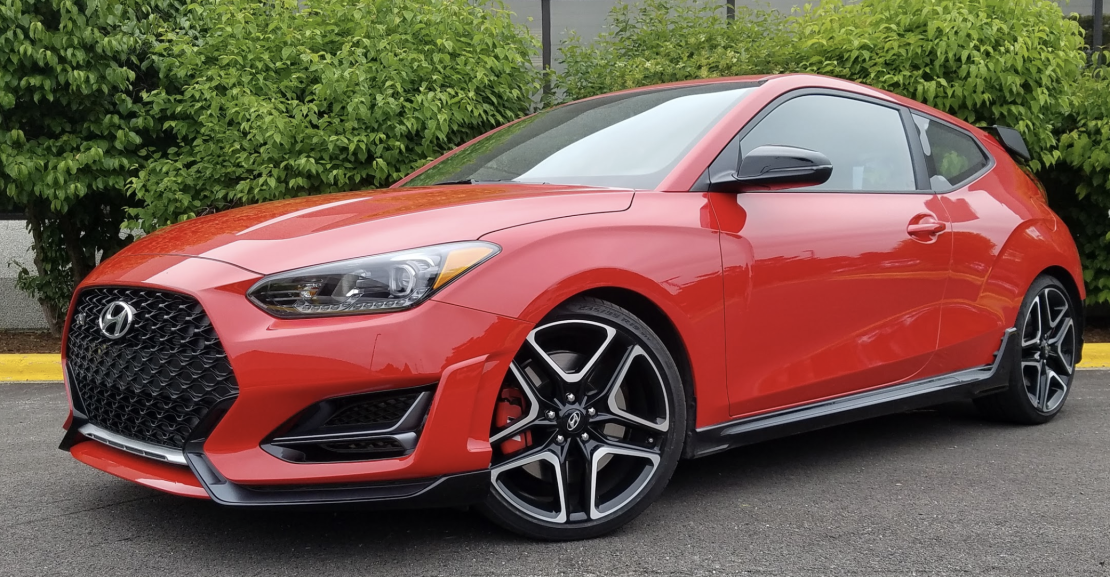
 2019 Hyundai Veloster N
2019 Hyundai Veloster N
Class: Sporty/Performance Car
Miles driven: 438
Fuel used: 18.3 gallons
| CG Report Card | |
|---|---|
| Room and Comfort | B- |
| Power and Performance | A- |
| Fit and Finish | C+ |
| Fuel Economy | B- |
| Value | B+ |
| Report-card grades are derived from a consensus of test-driver evaluations. All grades are versus other vehicles in the same class. Value grade is for specific trim level evaluated, and may not reflect Consumer Guide's impressions of the entire model lineup. | |
| Big & Tall Comfort | |
| Big Guy | B+ |
| Tall Guy | C+ |
| Big & Tall comfort ratings are for front seats only. "Big" rating based on male tester weighing approximately 350 pounds, "Tall" rating based on 6'6"-tall male tester. | |
| Drivetrain | |
| Engine Specs | 275-hp 2.0-liter |
| Engine Type | Turbo four |
| Transmission | 6-speed manual |
| Drive Wheels | Front-wheel drive |
Real-world fuel economy: 23.9 mpg
Driving mix: 60% city, 40% highway
EPA-estimated fuel economy: 22/28/25 (city/highway combined)
Fuel type: Premium Gas Recommended
Base price: $26,900 (not including $885 destination charge)
Options on test car: Performance Package ($2100)
Price as tested: $29,885
Quick Hits
The great: Performance driving experience, entertaining exhaust note
The good: Reasonably good passenger room, interior storage, and cargo space
The not so good: Rear outward visibility
More Veloster price and availability information
CG Says:
Hyundai’s unique 3-door Veloster hatchback further expands its performance envelope with the addition of the N trim level. It is based on existing turbocharged models but with a larger engine bringing a substantial horsepower boost, and it represents the first product of the company’s new N Brand performance division.

And that horsepower boost is quite substantial. While other turbo Veloster models get a 1.6-liter 201-horsepower engine, the N is blessed with a 2.0-liter making 250 horsepower, or 275 hp with the optional Performance Package. Our tester had that package, and the engine was linked to a slick-shifting 6-speed manual transmission (which is mandatory on the Veloster N) with short-throw shifter and rev-matching on downshifts – what turned out to be a very satisfying combination, indeed.
As we’ve covered the Veloster in a First Spin of the redesigned 2019 model along with test drives of 2019 base turbocharged R-Spec and higher-line Turbo Ultimate versions (we invite you to read those reports for more details), we’ll concentrate on the N’s differences here.

Besides the power increase, the N brings an N Grin Control System (Hyundai’s actual name for it) with Normal/Eco/Sport/Track/customizable settings, Torque Vectoring Control, electronically controlled suspension, 18-inch wheels with 225/40R18 Michelin Pilot Super Sport summer performance tires, two-stage rear spoiler, N Exclusive sport seats/leather-wrapped steering wheel/gauge cluster/floor mats, and a few more-mundane items such as automatic temperature control. Included in the $2100 Performance Package is the 275-hp engine along with 19-inch wheels wearing 235/35R-19 Pirelli P-Zero summer performance tires, a modified Corner Carving limited-slip differential with electronic control, a Variable Exhaust Valve System that allows for a louder exhaust note, and larger front and rear brakes.

It also brings a higher price. Whereas the R-Spec started at a very appealing $23,785 including the $885 destination charge, the Ultimate’s ante increased to $29,035; in between is the Turbo model. The N sits between the Turbo and Ultimate with a base price of $27,785, with the Performance Package adding $2100, bringing the total to $29,885.
It all adds up to a darn nice sporty hatchback/coupe. While there’s notable turbo lag, having a manual transmission lets you control that a little better – particularly on take-off – and the sudden surge of power it delivers when boost arrives is invigorating. Notable here is the exhaust note, which makes an appropriately sporty crackling sound on shifts. The shifter is a joy to use, handling is nearly sports-car nimble, and the ride isn’t as punishing as the low-profile tires and handling prowess might suggest.


As sporty compact coupes go, the Veloster is also fairly practical. Visibility is good except to the rear corners and straight back (the top of the rear window being low), though the visor doesn’t extend far enough when swung to the side to cover the whole window. Controls are easy to use and reach, interior storage is adequate, and there’s a decent amount of passenger space; an average-size adult would likely fit in the back seat, though not quite behind a fully rearward front seat. Getting in on the passenger side is “encouraged” with a rear door on that side only. Cargo room is also good, though while the rear seat backs release from the trunk – leaving a 3-inch step above the cargo floor – folding the driver-side one back up is a pain, as you have to reach back through the front door. (On the passenger side, there’s the rear door that not only makes getting in and out easier, but also makes it easier to raise the seat back.)
Others that play on the “hot hatch” field include the Mini hardtop and Clubman, Subaru BRZ and similar Toyota 86, and the venerable Volkswagen Golf GTI. Our favorite of these has long been the GTI, but for those seeking something a little different, the Veloster makes for an interesting alternative – in virtually any of its turbocharged forms.

Check out our Sporty/Performance Car Best Buys
Listen to the very entertaining Consumer Guide Car Stuff Podcast
2019 Hyundai Veloster N



